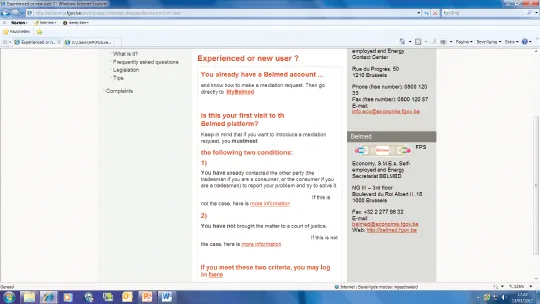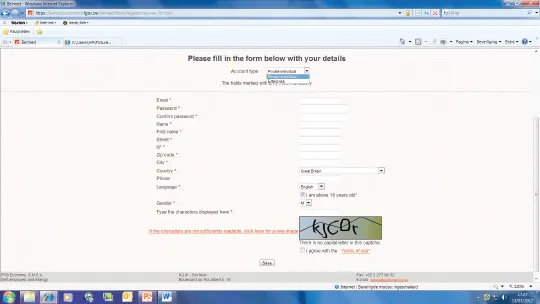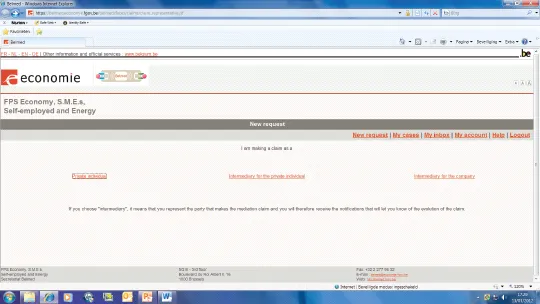![]()
2
Belgium
STEFAAN VOET
The New FPS Economy and its Mediation Task
After the 1999 elections, the Belgian federal government made the modernization of public administration one of its main priorities. A major reform of the various administrations, aimed at restoring citizens’ confidence in the public institutions, was announced. This program is known as the Copernicus reform.1 The core of it was that the citizen is not there for the administration, but that the administration and its civil servants must be at the service for the citizen. The latter, and not the administration, is at the centre.
One of the aims of the Copernicus reform was to restructure the federal administrations.2 The ministries were replaced by Federal Public Services (FPSs) and Federal Public Planning Services (PPSs).3 The tasks entrusted to the former are the same as those given to the former ministries. The latter handle ad hoc matters associated with socially-based issues that require coordination between several FPSs, such as the policy on equal opportunity or sustainable development.
In 2002, and in this context, the Ministry of Economic Affaires was reformed to the FPS Economy, SMEs,4 Self-Employed and Energy.5 Its task is to create the conditions required for the competitive, sustainable and balanced operation of the goods and services market in Belgium. To achieve this aim, the FPS plays an active and effective part in controlling the overall standards framework of the country’s economic and monetary union.
The Copernicus reform was extended to the Directorate-Generals of the Ministry. From then on, the Directorate-General responsible for enforcement was called the Directorate-General Enforcement and Mediation. In particular, the ‘mediation part’ was added. The reason for this is unclear. The content of the mediation task was totally left open, so the Directorate-General was given a free and broad discretion to interpret it.
From the beginning, one thing was clear: besides ethical objections, the Directorate-General did not have the financial resources and infrastructure to intervene or mediate in individual (consumer) cases. In the beginning of the new century, markets were liberalized (eg the energy and telecommunication market). This gave cause for a lot of consumer complaints. The first thing the Directorate-General did, under the mediation umbrella, was sectorial mediation. They invited the market players (business and consumer associations) and tried to solve complaints on a sectorial basis.
Because the Directorate-General is convinced of the fact that creating a favourable environment for consumer A(O)DR leads to a better functioning of the goods and services market,6 it decided, still under the mediation umbrella, to promote A(O)DR. This led to the Belmed project.
Creation of Belmed
Belmed was created in three phases. First of all, a feasibility study was ordered on the introduction of an online mediation tool. The study was carried out in 2005–2006 by the Research Center on IT & Law of the University of Namur and the Brussels Management School.7 The research explored the legal, economical and technical (IT) possibilities of online mediation. One of the conclusions was to establish a private – public partnership to create an ODR tool.
In a second phase, and on the basis of this study, a stakeholder consultation was organized with business associations, consumer associations, ombuds services, etc. The enthusiasm was great, except for the financial aspect. None of the stakeholders wanted to support the project financially.
In a third and final phase, a European tender was launched at the end of 2009 to develop the software. Eight companies were interested, including IBM. In January 2010, the tender was assigned to IRIS Solutions & Experts, an IT company from Louvain-la-Neuve.
Belmed, which is an abbreviation for Belgian Mediation,8 was presented in April 2011. It is a digital portal (platform) on ADR and ODR, which it wants to promote and make more accessible. Belmed consists of two pillars: on the one hand offering information on ADR, and on the other hand providing ODR for consumers and enterprises.
Belmed only applies to consumer disputes (non-commercial disputes are excluded) and disputes between a consumer residing in one of the 27 EU member states, and an enterprise that is registered in the Belgian Register for Companies, or vice versa (disputes between consumers and disputes between enterprises are excluded).
The website of Belmed is www.belmed.fgov.be, and is available in Dutch, French, German and English:
Information
On the one hand, the information part contains a guide on how to settle a dispute in an amicable way.9 It not only explains what a formal notice,10 a consumer dispute,11 a third party,12 and alternative dispute resolution13 are, but also offers concrete examples of eg a formal notice:
Place and date
Name and address of the sender
Name and address of the addressee
Dear Sir or Madam,
Re: purchase of …… (description) – invoice/order form reference – … (date)
I have bought the above-mentioned … from you on … (date).
The contract (or order form) mentions a precise deadline (or date) for the delivery: ....... This deadline (or date) is now over.
As I still have not heard from you, I enjoin and ask you to take all the necessary measures to proceed to the delivery during the next … days.
Yours faithfully,
Signature
Other examples of letters can be found under ‘Tips’:14 eg a general purpose registered letter, a registered letter dealing with a product breaking down, and a registered letter to terminate a contract.
On the other hand, the information part offers a convenient outline of all existing ADR tools in Belgium.15 It gives an overview of all Belgian arbitration,16 conciliation,17 mediation,18 and ombudsmen agencies.19 All this information is also offered per sector20 (consumer goods, general consumer services, financial services, postal services and electronic communications, transport services, leisure services, energy and water, health, education, and cross-border disputes) and subsector.21 The information outline of each agency is similar. At a single glance, all relevant information can be consulted: the address, the website, for which problems the agency is competent, the prerequisites for access, how the process works, a complaint form, the rules, and the costs.22
The information part finally contains some frequently asked questions,23 an overview of relevant (Belgian and European) legislation and some tips.
All the aforementioned information is explained in a plain and accessible language, thereby avoiding legalese.
Online Application
On the other hand, and this is the second pillar, Belmed offers the possibility of making an online application for arbitration, conciliation, or mediation. The idea is to create one digital portal, or access point, for the consumer and tradesman. After an application is made, the Belmed system will automatically send it to the competent agency. So, the consumer or tradesman do not have to find out, in advance, which agency is competent for their dispute.
If a consumer or tradesman wants to make an application, he/she has to click on the ‘make a request for mediation’ link on the introductory webpage24 (see the screenshot supra).
The consumer or tradesman who visits the Belmed platform for the first time, will be faced with two ‘accessibility criteria’. On the one hand, an application can only be made when one has already contacted the other party to report the problem and try to solve it. If not, the applicant will be referred to the aforementioned guide in the information part, which contains an example of a formal notice. On the other hand, an application can only be made if there is no court proceeding pending. If so, the applicant will receive (albeit limited) information on how to mediate during a court proceeding.25
If the applicant has contacted the other party to no avail, and there is no court proceeding pending, he/she can log in and register.
There are two ways to register.26 First of all, every Belgian resident can use his or her electronic ID card or token with the federal authentication portal to register. Secondly, every Belgian resident and every European consumer can create a personal Belmed account. All European consumers can use the system. For the moment, they can only do so when they have a dispute with a company that is registered in the Belgian Register for Companies (eg a German consumer who lives in Berlin and bought a second hand vehicle in Antwerp, or an Englishman who lives in Brussels and has a dispute with a real estate agency in Bruges).
Every private individual, or enterprise, can create a personal Belmed account. The applicant has to fill out the following information: email, password, name, first name, street, n°, zip code, city, country, phone, language (Dutch, French, German, or English), and gender. The applicant also has to agree with the terms of use.27
When the consumer or tradesman has registered, he/she receives a confirmation email with a link to validate the registration.
The Belmed account consists of different parts: making a new request, an overview of all (current and previous) applications (‘my cases’), an email inbox (‘my inbox’), a link to the account (where the applicant can edit his or her personal information) (‘my account’), and a help link.
A new request can be made in three capacities: as a private individual consumer, as an intermediary for a private individual consumer (eg a son making an application for his 80-year old grandmother who has a problem with her electricity supplier, or a father making an application for his 15-year old son who has a problem with his new cell phone), and as an intermediary for a company (eg a lawyer or accountant).
The structure of the online request is based on Commission Recommendation 2010/304/EU of 12 May 2010 on the use of a harmonised methodology for classifying and reporting consumer complaints and enquiries.28
Preliminarily, the applicant will be confronted, for the second time, with the two ‘accessibility criteria’: ‘have you contacted the tradesman/consumer concerned to report your problem?’ and ‘did you take the matter to court?’. Then the applicant has to provide inf...





